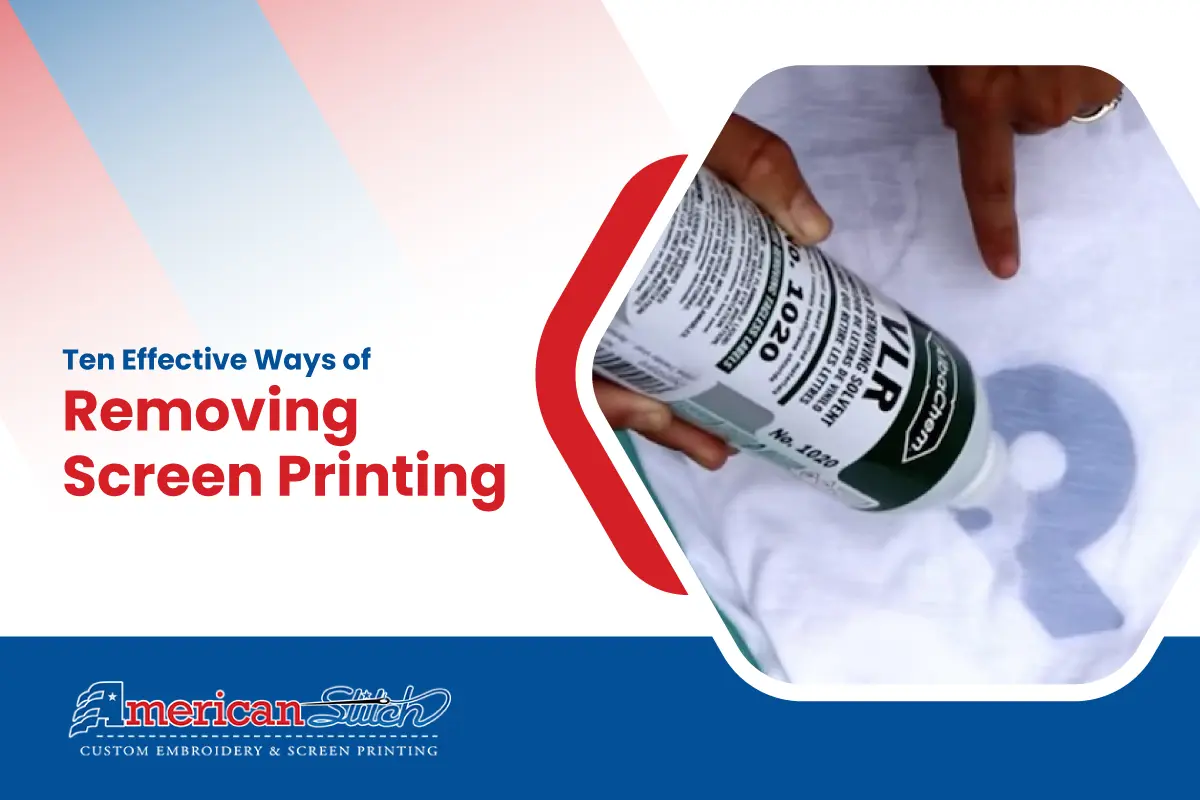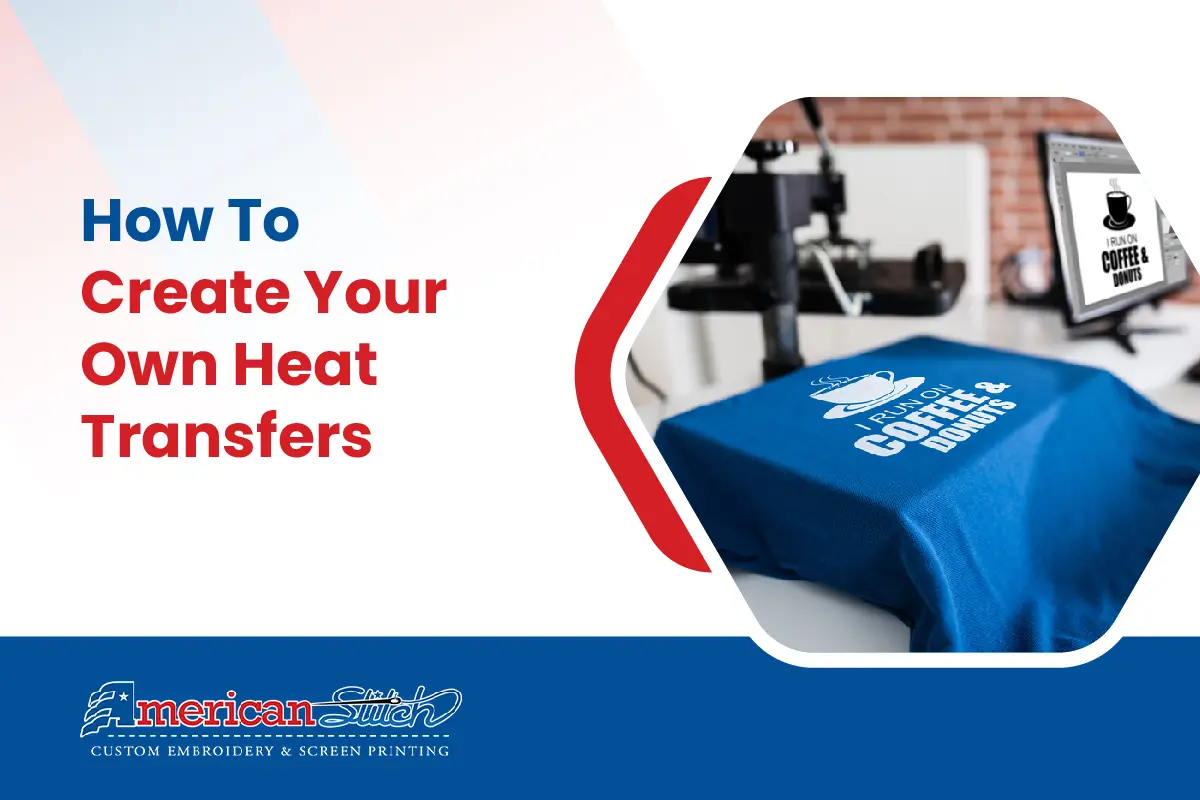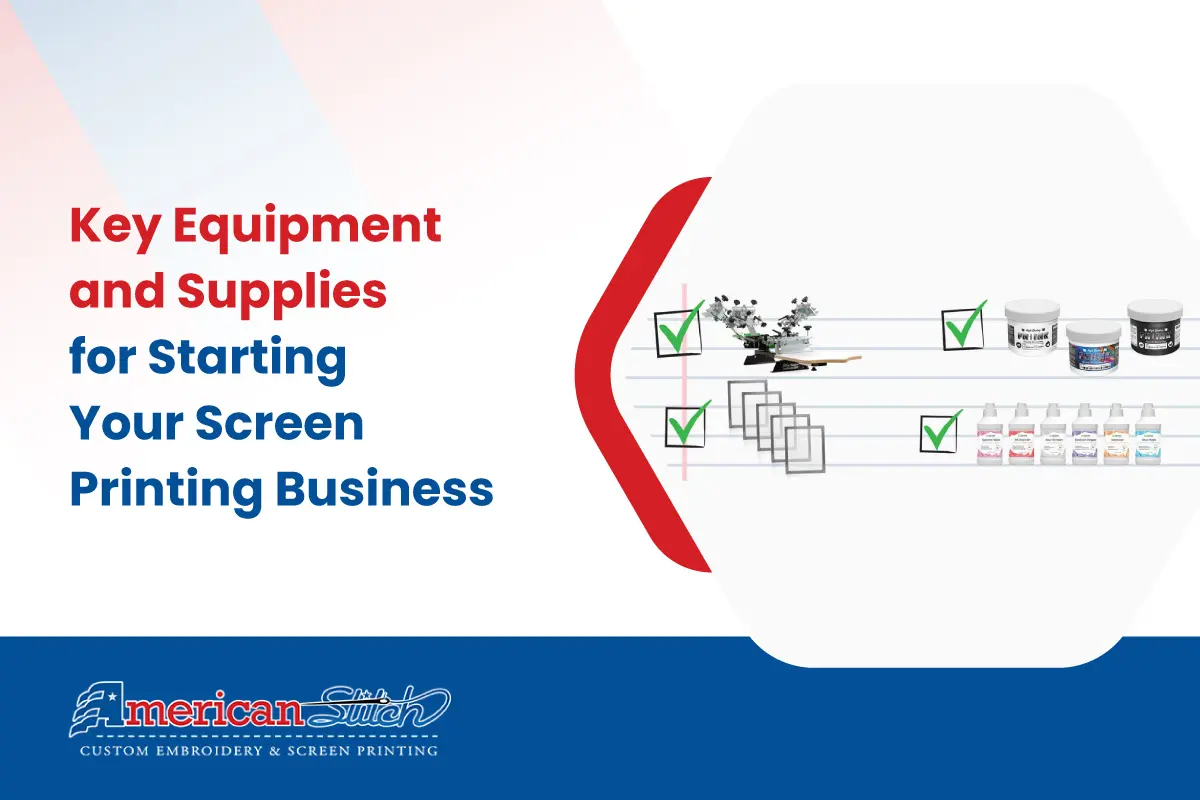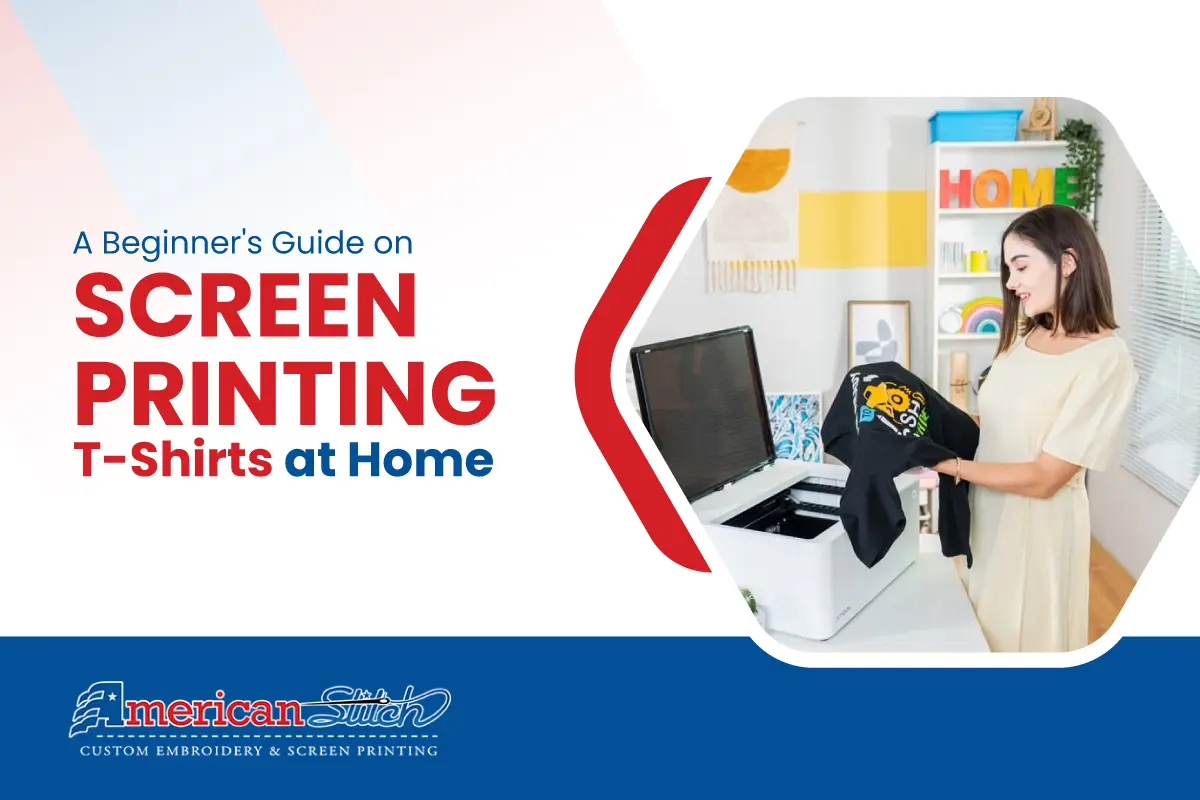Screen printing, also known as silk screening, is a printing technique that involves creating a stencil (or screen) of a design and then using that stencil to transfer ink onto a surface, such as fabric or paper.
The stencil is made by covering a mesh screen with a light-sensitive emulsion and then exposing it to light, which hardens the emulsion in the areas where the design is not present. The unhardened emulsion is then washed away, leaving a stencil that can be used to apply ink to the surface.
This process can be repeated with different stencils to create multi-color designs. Screen printing is commonly used for printing t-shirts, posters, signs, and other promotional materials.
Table of Contents
How to Remove Screen Printing From Shirt?
There are several methods you can use to remove screen prints from a shirt. Turn the shirt inside out and lay it on a flat surface. Soak a clean cloth in rubbing alcohol and dab it onto the screen print area. Make sure the cloth is damp but not soaking wet. Let the alcohol sit on the screen print for a few minutes to allow it to break down the ink.
Use a scraper tool or your fingernail to gently scrape away the screen print. Be careful not to damage the fabric of the shirt. Repeat the process until the screen print is completely removed. Wash the shirt in cold water to remove any remaining alcohol or ink residue.
You can also try other methods such as using a mixture of baking soda and hot water, using a heat gun or hair dryer to soften the ink, or using a chemical ink remover. It’s important to always test the method on a small, inconspicuous area of the shirt first before proceeding to remove the screen print from the rest of the shirt.
Removing Screen Printing on Heat Press
A heat press is a machine used to transfer a design or graphic onto a substrate or material, such as a t-shirt, hat, or bag.
It works by applying heat and pressure to a transfer paper or vinyl that has the desired design on it, causing the ink or vinyl to transfer onto the surface of the material. Heat presses are commonly used in the garment industry and by hobbyists for creating personalized clothing and accessories.
They come in different sizes and configurations, including manual, semi-automatic, and fully automatic models.
Common Removal Solutions Techniques
There are many options available for removing screen printing from your item. You can use any removing techniques from the below. Here are some common techniques for removing screen printing:
Chemical solvents: Solvents like acetone, rubbing alcohol, or paint thinner can be effective in breaking down the ink and making it easier to remove.
Heat: Using a heat gun or hair dryer to soften the ink and then scraping it off can be effective for small areas of screen printing.
Abrasives: Sandpaper, steel wool, or a pumice stone can be used to scrub away the ink, but be careful not to damage the underlying material.
Adhesive removers: Products like Goo Gone or WD-40 can help dissolve the ink and make it easier to scrape away.
Pressure washing: A high-pressure washer can blast away the ink, but again, be careful not to damage the material underneath.
It’s important to note that the effectiveness of these techniques can vary depending on the type of ink and material being used, so it’s best to test a small area first before attempting to remove the entire screen print.
Natural Solutions
Several natural solutions can be used for removing screen printing. Here are some of them:
Lemon Juice and Baking Soda: Mix equal parts of lemon juice and baking soda to form a paste. Apply the paste onto the screen printing and scrub it gently with a soft-bristled brush. Rinse with water and repeat if necessary.
Vinegar: Soak the clothing in a solution of equal parts vinegar and water for 30 minutes. Scrub the screen printing with a soft-bristled brush and rinse with water.
Hydrogen Peroxide: Mix equal parts of hydrogen peroxide and water. Apply the solution onto the screen printing and let it sit for 10 minutes. Scrub gently with a soft-bristled brush and rinse with water.
Salt and Vinegar: Mix 1/4 cup of salt and 1/4 cup of vinegar to form a paste. Apply the paste onto the screen printing and let it sit for 10 minutes. Scrub gently with a soft-bristled brush and rinse with water.
These natural solutions may take longer and require more effort than chemical solutions, but they are generally safer for the environment and may be gentler on the fabric.
Chemical Solutions
Chemical solutions for removing screen printing typically involve using solvents or ink removers that break down the ink or adhesive used in the printing process. Common chemical solutions include:
Acetone: A strong solvent that can dissolve most types of ink. It is commonly used to remove screen printing from hard surfaces like metal or glass.
Rubbing alcohol: A weaker solvent that can dissolve some types of ink. It is a good option for removing screen printing from fabrics or other delicate surfaces.
Goo Gone: A commercial adhesive remover that can dissolve the adhesive used to attach the screen printing to the surface.
Ink Be Gone: A commercial ink remover that can dissolve many types of ink, including screen printing ink.
Citristrip: A commercial paint stripper that can dissolve both ink and adhesive used in screen printing. It is a stronger solution and should be used with caution.
It is important to follow the instructions for these chemical solutions carefully and use them in a well-ventilated area. Wear gloves and protective eyewear to avoid skin and eye irritation.
Ten Effective Methods for Removing Screen Printing
Great, here are eleven effective methods for removing screen printing:
- Soaking with hot water and laundry detergent
- Scrubbing with a brush and hot water
- Using a scraper tool, such as a razor blade or putty knife
- Using a solvent, such as acetone or rubbing alcohol
- Using an adhesive remover, such as Goo Gone
- Applying a paint stripper, such as Citristrip
- Using a heat gun or hair dryer to soften the ink and scrape it away
- Applying a chemical ink remover, such as Ink Be Gone
- Using a pressure washer to blast away the ink
- Applying a vinyl remover solution, such as VLR.
It’s important to note that each method has its own pros and cons, and it’s important to choose the right method for the item you are working with. Always follow safety instructions carefully, test a small area first, and be patient, as removing screen printing can take time and multiple attempts.
:max_bytes(150000):strip_icc()/solving-hard-water-laundry-problems-2146651_01-bbe569d17e744170957969af57770ba5.jpg)
1. Soaking With Hot Water and Laundry Detergent
Soaking the item in hot water and laundry detergent is a simple and effective way to remove screen printing.
- Fill a basin or sink with hot water and add a generous amount of laundry detergent.
- Place the item in the water and make sure it’s fully submerged.
- Let the item soak for several hours or overnight.
- Remove the item from the water and scrub gently with a brush to remove the screen printing.
- Rinse the item thoroughly with clean water.
This method is best for items made of fabric or clothing, but can also work for some other materials. It’s important to note that some types of ink or dyes may be more stubborn and may require additional methods for removal. Also, be sure to check the care label of the item before soaking it, as some fabrics may not be able to withstand hot water or laundry detergent.

2. Scrubbing With a Brush and Hot Water
Scrubbing the item with a brush and hot water is another effective way to remove screen printing. Here’s how to do it:
- Fill a basin or sink with hot water.
- Wet the item and place it in the water.
- Apply a generous amount of dish soap or laundry detergent to the screen printed area.
- Use a stiff-bristled brush to scrub the area vigorously in a circular motion, applying pressure as needed.
- Rinse the item thoroughly with clean water.
This method works best for items made of fabric or clothing, but can also work for some other materials. It’s important to note that some types of ink or dyes may be more stubborn and may require additional methods for removal. Also, be sure to check the care label of the item before scrubbing it, as some fabrics may not be able to withstand vigorous scrubbing.

3. Use a Scraper Tool, Such As a Razor Blade or Putty Knife
Using a scraper tool, such as a razor blade or putty knife, is a more aggressive method for removing screen printing. Here’s how to do it:
- Lay the item on a flat surface and secure it so it doesn’t move around.
- Hold the scraper tool at a 45-degree angle and gently scrape the screen printed area, applying pressure as needed.
- Be careful not to scrape too hard or you may damage the item or leave scratches on the surface.
- Once you have removed as much of the screen printing as possible, clean the area with hot water and dish soap or laundry detergent.
- Rinse the item thoroughly with clean water.
This method works best for items made of hard surfaces, such as metal or plastic, but can also work for some fabrics. It’s important to note that using a scraper tool can be risky, as you may accidentally damage the item or scratch the surface. Use caution and start with gentle pressure, gradually increasing as needed.

4. Using a Solvent, Such As Acetone or Rubbing Alcohol
Using a solvent, such as acetone or rubbing alcohol, is an effective method for removing screen printing.
- Lay the item on a flat surface and secure it so it doesn’t move around.
- Apply a small amount of solvent, such as acetone or rubbing alcohol, to a clean cloth or cotton ball.
- Test the solvent on an inconspicuous area first to make sure it doesn’t damage or discolor the item.
- Gently rub the screen printed area with the cloth or cotton ball, applying pressure as needed.
- Continue rubbing until the screen printing starts to come off.
- Once you have removed as much of the screen printing as possible, clean the area with hot water and dish soap or laundry detergent.
- Rinse the item thoroughly with clean water.
This method works best for items made of hard surfaces, such as metal or plastic, but can also work for some fabrics. It’s important to note that some solvents can be harsh and may damage certain materials or colors, so it’s important to test them first and use caution. Additionally, make sure to use solvents in a well-ventilated area and avoid inhaling the fumes.

5. Using An Adhesive Remover, Such As Goo Gone
Using an adhesive remover, such as Goo Gone, is an effective method for removing screen printing.
- Lay the item on a flat surface and secure it so it doesn’t move around.
- Apply a small amount of adhesive removers, such as Goo Gone, to a clean cloth or cotton ball.
- Test the adhesive remover on an inconspicuous area first to make sure it doesn’t damage or discolor the item.
- Gently rub the screen printed area with the cloth or cotton ball, applying pressure as needed.
- Continue rubbing until the screen printing starts to come off.
- Once you have removed as much of the screen printing as possible, clean the area with hot water and dish soap or laundry detergent.
- Rinse the item thoroughly with clean water.
You can also see this YouTube video for clear understanding of usage of Goo Gone,
This method works best for items made of hard surfaces, such as metal or plastic, but can also work for some fabrics. It’s important to note that some adhesive removers can be harsh and may damage certain materials or colors, so it’s important to test them first and use caution. Additionally, make sure to use adhesive removers in a well-ventilated area and avoid inhaling the fumes.
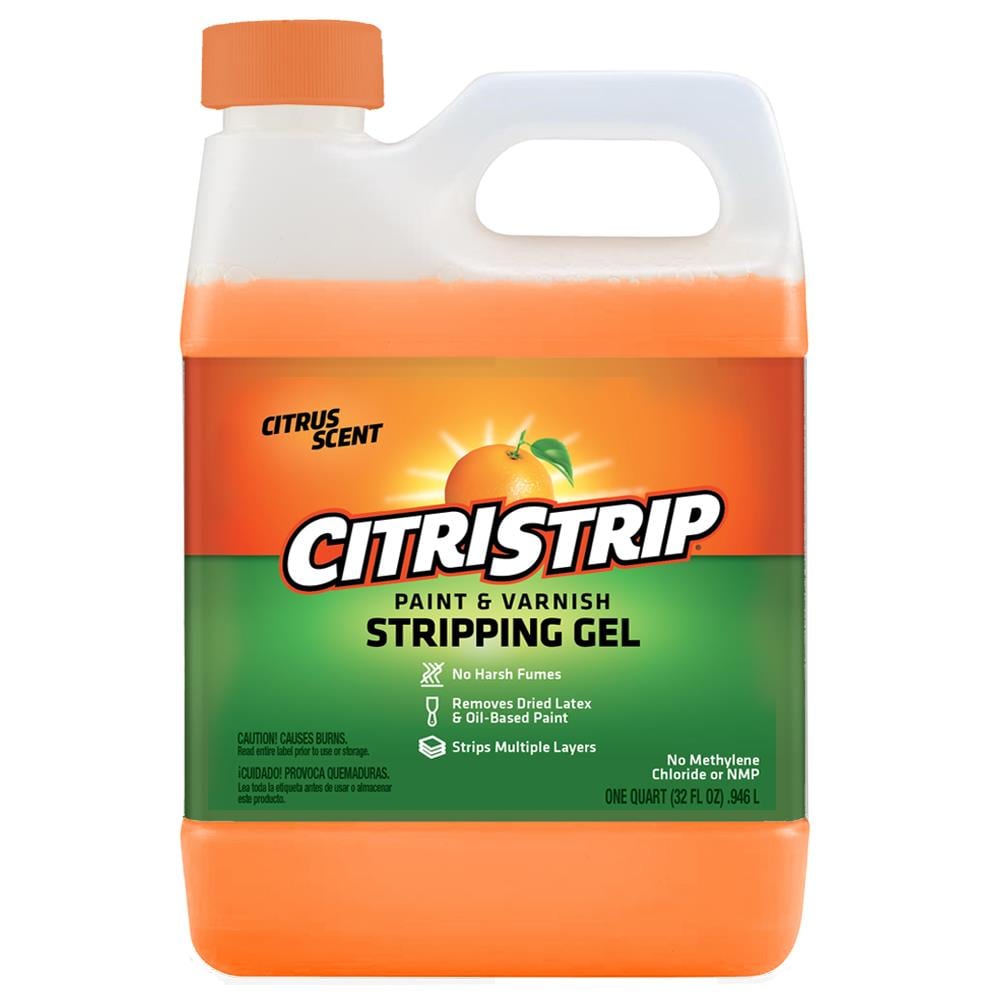
6. Applying a Paint Stripper, Such as Citristrip
Applying a paint stripper, such as Citristrip, is another effective method for removing screen printing.
- Wear protective gloves and work in a well-ventilated area.
- Apply a layer of paint stripper, such as Citristrip, to the screen printed area with a brush or rag.
- Let the paint stripper sit for the amount of time recommended by the manufacturer, usually around 30 minutes to an hour.
- Use a scraper or putty knife to gently scrape off the screen printing, being careful not to damage the surface underneath.
- If necessary, repeat the process until all the screen printing is removed.
- Once you have removed as much of the screen printing as possible, clean the area with hot water and dish soap or laundry detergent.
- Rinse the item thoroughly with clean water.
This method is best suited for hard surfaces such as metal or plastic and should be avoided on delicate fabrics. It’s also important to note that some paint strippers can be harsh and may damage certain materials or colors, so it’s important to test them first and use caution.

7. Use a Heat Gun or Hair Dryer to Soften The Ink and Scrape It Away
Using a heat gun or hair dryer to soften the ink and scrape it away is another effective method for removing screen printing.
- Lay the fabric or item with the screen printing face down on a flat surface.
- Heat the back of the fabric or item using a heat gun or hair dryer on high heat, holding it about 2 inches away from the surface.
- Heat the area for about 30 seconds or until the ink softens and begins to bubble.
- Use a scraper tool, such as a razor blade or putty knife, to gently scrape away the ink. Be careful not to scratch or damage the surface underneath.
- Continue heating and scraping until all of the screen printing is removed.
- Once you have removed as much of the screen printing as possible, clean the area with hot water and dish soap or laundry detergent.
- Rinse the item thoroughly with clean water.
This method is best suited for hard surfaces and should be avoided on delicate fabrics. It’s important to use caution and not overheat the fabric or surface, which can cause damage or scorching.
8. Applying a Chemical Ink Remover, Such as Ink Be Gone
Applying a chemical ink remover, such as Ink Be Gone, is another effective method for removing screen printing.
- Put on gloves to protect your hands and work in a well-ventilated area.
- Apply the ink remover to the screen printing area with a brush, sponge, or cloth. Be sure to follow the manufacturer’s instructions carefully.
- Let the remover sit on the surface for the recommended amount of time.
- Use a scraper tool, such as a razor blade or putty knife, to gently scrape away the ink.
- Continue applying the remover and scraping until all of the screen printing is removed.
- Once you have removed as much of the screen printing as possible, clean the area with hot water and dish soap or laundry detergent.
- Rinse the item thoroughly with clean water.
It’s important to follow the manufacturer’s instructions and safety precautions when using a chemical ink remover. Be sure to wear gloves and work in a well-ventilated area to avoid exposure to harmful fumes.
9. Using a Pressure Washer to Blast Away The Ink
Using a pressure washer is another method for removing screen printing, especially for larger items or outdoor surfaces.
- First, make sure you have the appropriate pressure washer for the job. A pressure washer with a minimum of 2000 PSI and a 15-degree nozzle is recommended for removing screen printing.
- Wear safety goggles and protective clothing, as the pressure washer can kick up debris and ink particles.
- Test a small, inconspicuous area to ensure that the pressure washer won’t damage the material.
- Point the pressure washer nozzle at a 45-degree angle and hold it about 6-8 inches away from the surface.
- Begin spraying the area with the pressure washer, moving the nozzle back and forth in a sweeping motion.
- Gradually increase the pressure and move closer to the surface as needed to remove the screen printing.
- Once you have removed as much of the screen printing as possible, clean the area with hot water and dish soap or laundry detergent.
- Rinse the item thoroughly with clean water.
It’s important to use caution when using a pressure washer, as the high pressure can damage delicate materials or even cause injury if not used properly. Test a small area first, and always wear appropriate safety gear to protect yourself.
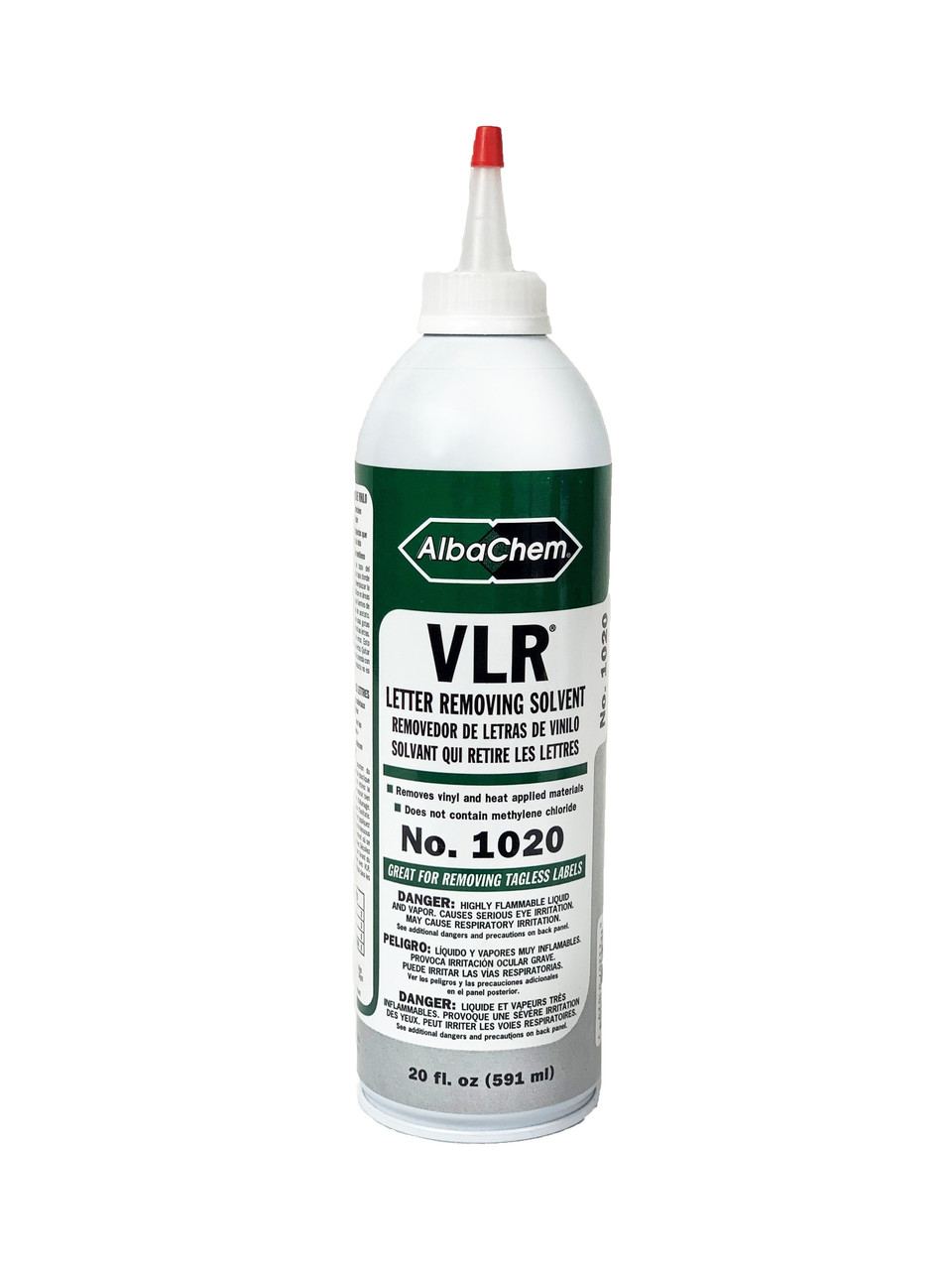
10. Applying a Vinyl Remover Solution, Such As VLR
Applying a vinyl remover solution, such as VLR, is another effective method for removing screen printing. Here’s a summary of how to do it:
- Choose a well-ventilated area and wear gloves to protect your hands.
- Apply the vinyl remover solution to the screen printing, following the instructions on the product label.
- Allow the solution to sit on the screen printing for the recommended amount of time. This can vary depending on the product, so be sure to read the label carefully.
- Use a scraper or putty knife to gently lift the screen printing from the surface. Be careful not to damage the material underneath.
- If necessary, repeat the process until all the screen printing has been removed.
- Clean the area with soap and water to remove any remaining residue from the vinyl remover solution.
It’s important to follow the instructions on the product label and wear appropriate protective gear when using a vinyl remover solution. Test the solution on a small, inconspicuous area first to ensure that it won’t damage the material.
Here Are Some Tips and Tricks to Keep in Mind When Remove Screen Printing
Test a small, inconspicuous area first to ensure that the method you are using does not damage the fabric or surface. Always wear gloves and work in a well-ventilated area when using chemicals or solvents. Use a gentle touch and avoid using too much pressure, which can damage the fabric or surface.
For stubborn ink stains, repeat the process multiple times or try a different method. Use a scraper tool with caution to avoid cutting or scratching the fabric or surface. Use a heat gun or hairdryer on a low setting to avoid scorching the fabric or surface. Always read and follow the instructions on any product you are using.
After removing the screen printing, launder or clean the fabric or surface according to the manufacturer’s instructions. Consider taking the item to a professional if you are unsure or uncomfortable with removing the screen printing yourself.
How to Remove Screen Printing From Shirt
There are several methods you can use to remove screen prints from a shirt. Turn the shirt inside out and lay it on a flat surface. Soak a clean cloth in rubbing alcohol and dab it onto the screen print area. Make sure the cloth is damp but not soaking wet. Let the alcohol sit on the screen print for a few minutes to allow it to break down the ink.
Use a scraper tool or your fingernail to gently scrape away the screen print. Be careful not to damage the fabric of the shirt. Repeat the process until the screen print is completely removed. Wash the shirt in cold water to remove any remaining alcohol or ink residue.
You can also try other methods such as using a mixture of baking soda and hot water, using a heat gun or hair dryer to soften the ink, or using a chemical ink remover. It’s important to always test the method on a small, inconspicuous area of the shirt first before proceeding to remove the screen print from the rest of the shirt.
Final Thoughts Removing Screen Printing
Overall, there are many different methods and solutions available for removing screen printing from various surfaces, including clothing, polyester, plastic, and more. The best approach will depend on the specific material and ink used in the screen printing, as well as the tools and materials available to you.
It’s important to always test any removal method on a small, inconspicuous area first, and to follow all safety precautions when working with chemicals or heat sources. With patience and persistence, it is possible to effectively remove unwanted screen printing and restore the appearance of your items.
Frequently Asked Questions
Is there a way to remove screen printing from a shirt?
Yes, there are several ways to remove screen printing from a shirt. Some common methods include using a solvent such as acetone or rubbing alcohol, soaking the shirt in hot water and laundry detergent, or using a scraper tool like a razor blade or putty knife.
The effectiveness of these methods may vary depending on the type of ink and fabric used in the screen printing process, so it’s important to test a small area first and proceed with caution. It’s also worth noting that some methods may damage the fabric or leave behind residue, so it’s important to follow proper instructions and take appropriate precautions.
How can I remove a print without damaging the T-shirt?
Soak the shirt in hot water and laundry detergent for several hours, then gently scrub with a soft-bristled brush. Use a scraper tool, such as a razor blade or putty knife, to carefully scrape off the print. Apply a solvent, such as rubbing alcohol or acetone, to a clean cloth and gently dab the print until it begins to lift off. Use a heat gun or hairdryer to soften the ink and gently scrape it away with a scraper tool or your fingernail.
Is there a way to remove a brand logo from a sweatshirt?
Yes, there are several ways to remove a brand logo from a sweatshirt, depending on the type of logo and material of the sweatshirt. Some methods include soaking the sweatshirt in hot water and laundry detergent, using a scraper tool, applying a solvent or adhesive remover, using a heat gun or hairdryer, and sandblasting. However, it’s important to note that some methods may cause damage to the sweatshirt or affect its quality. It’s recommended to test any method on a small, inconspicuous area of the sweatshirt before proceeding with the entire logo removal process.
How do you remove printed letters from a shirt?
One way to remove printed letters from a shirt is to use a combination of heat, a scraping tool, and a solvent. First, use a heat source such as a hairdryer or heat gun to soften the ink. Then, use a scraping tool like a putty knife to gently scrape off the letters. Finally, use a solvent such as rubbing alcohol or acetone to remove any remaining residue.
How do I remove a rubber print from clothes?
One method to remove rubber print from clothes is to apply rubbing alcohol or acetone on the print, then scrape it off with a putty knife or scraper tool. Another method is to use a heat gun to soften the rubber print, then scrape it off carefully.
Are screen printing screens reusable?
Yes, screen printing screens are typically reusable. However, the number of times a screen can be reused depends on various factors, such as the type of ink used, the mesh count of the screen, and the cleaning and storage methods employed after each use. With proper care and maintenance, a screen can be used multiple times before it needs to be replaced.
Is there any way I can fix a cracked T-shirt print?
One possible way to fix a cracked T-shirt print is to carefully use a fabric marker or paint to fill in the cracks and reinforce the design. Another option is to cover the cracked area with a patch or applique, either by sewing it on or using fabric glue. However, these methods may not completely restore the appearance of the original design and the T-shirt may need to be replaced.
How do I clean a screen printing screen?
To clean a screen printing screen, you can use a dedicated screen cleaning solution and a brush to remove excess ink and debris. Wet the screen with water, apply the cleaning solution, and scrub both sides of the screen with the brush. Rinse the screen thoroughly with water and allow it to dry completely before using it again.

